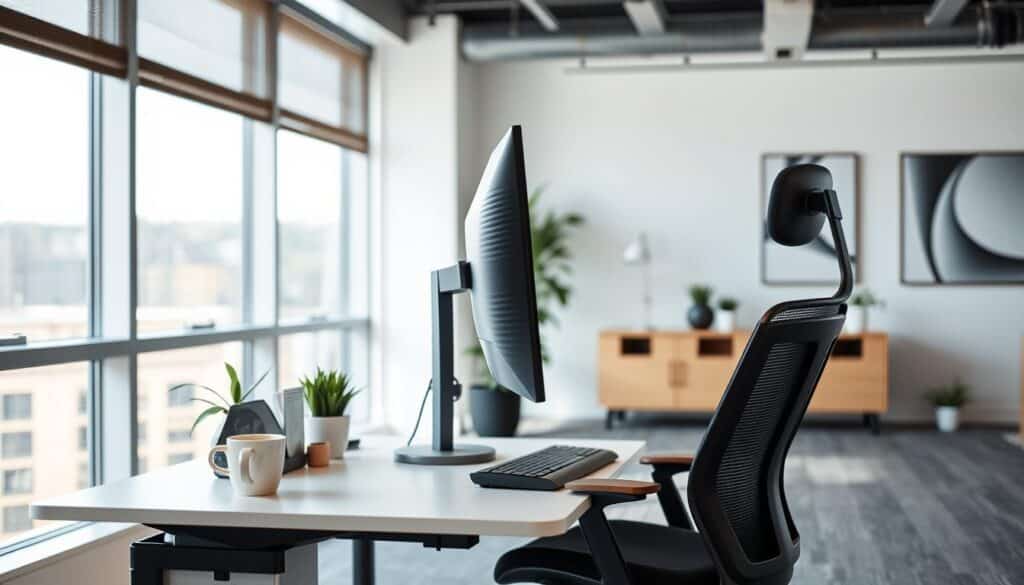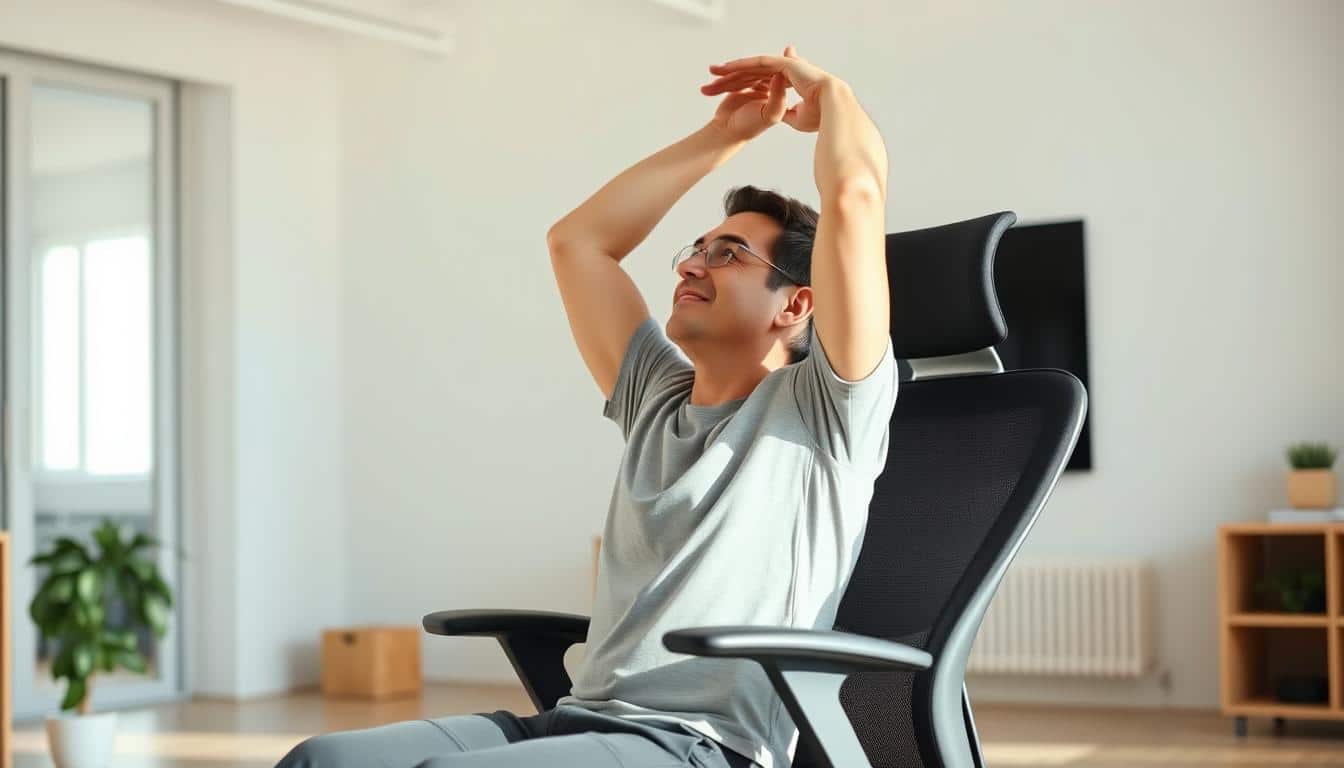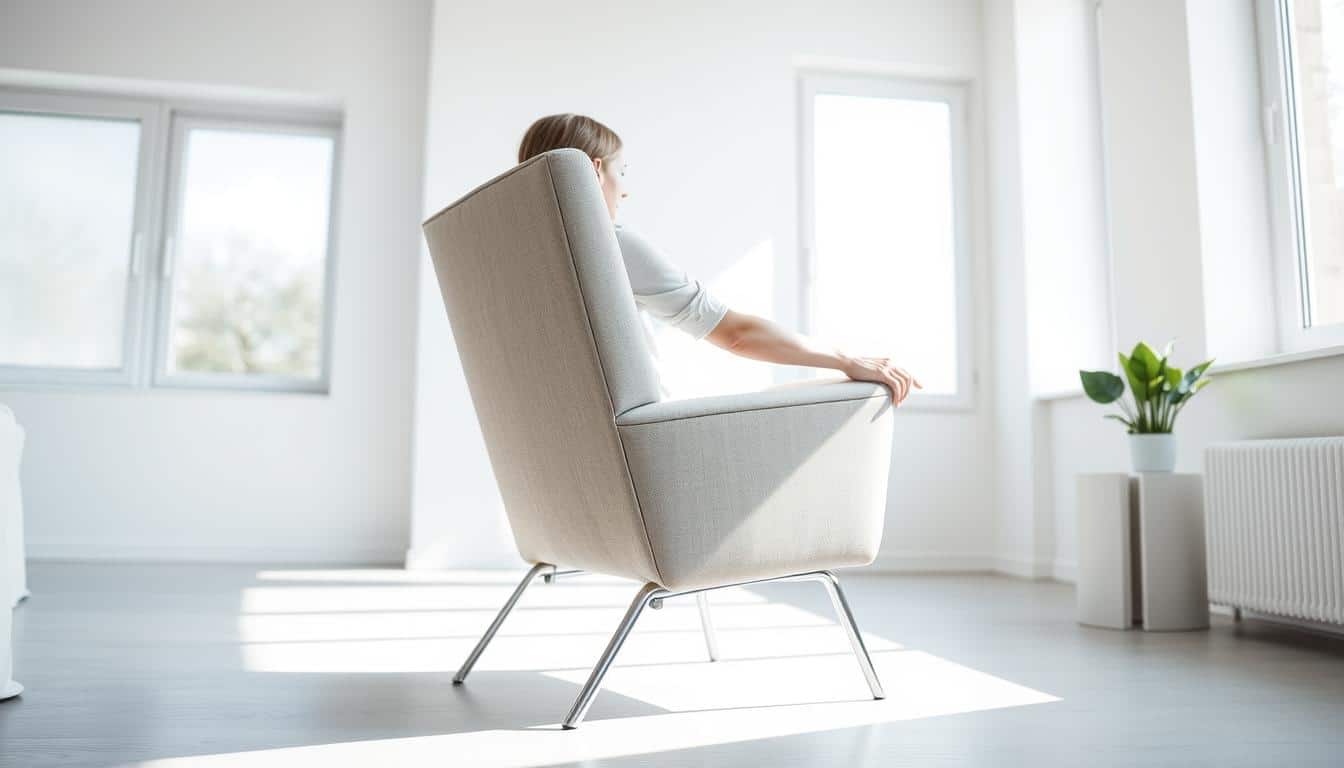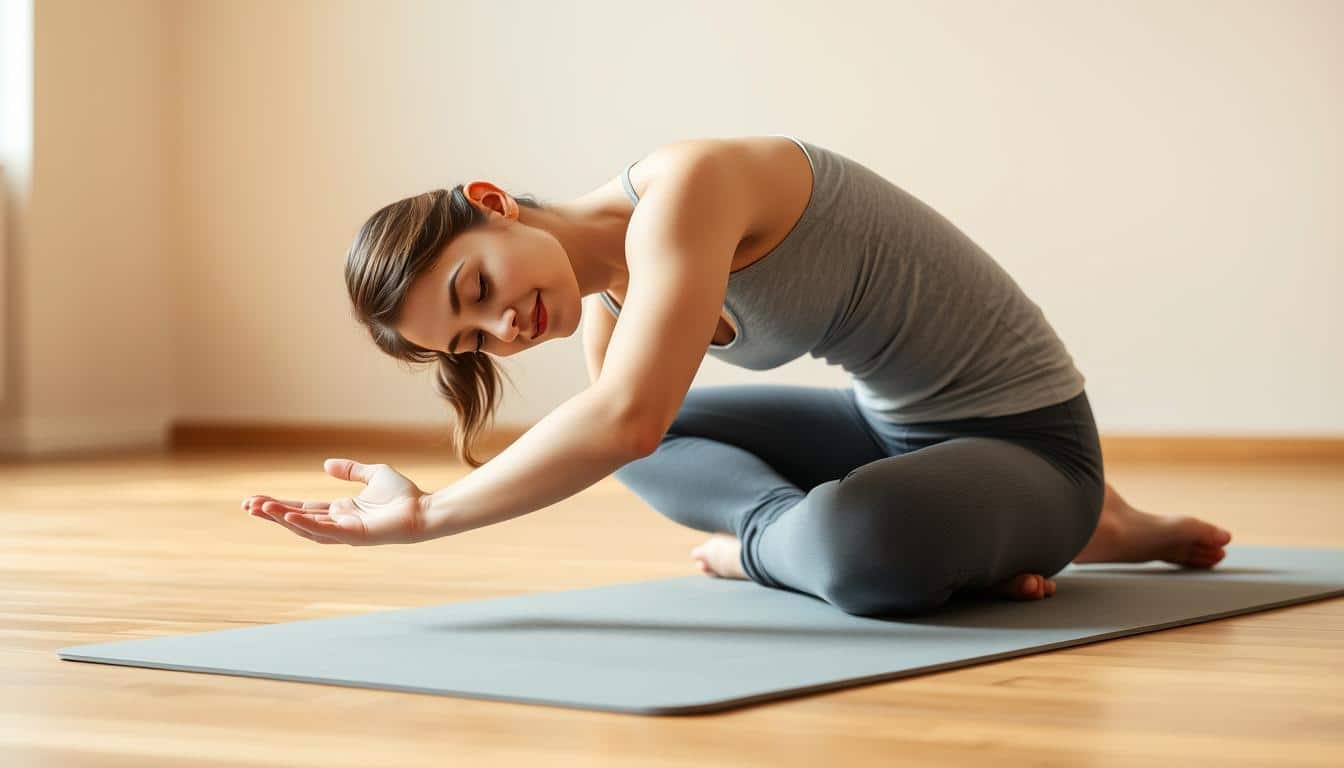Anúncios
Meta title: Workplace Stretching Tips for Daily Desk Refresh
Meta description: Energize your workday with stretching tips to do at your workplace. Find easy exercises to reduce strain and boost productivity!
Anúncios
This short guide offers practical, easy-to-follow workplace stretches and a simple desk stretch routine for people who spend long hours seated. Whether you’re a remote worker using a home office, an in-office employee at a company like Google or Wells Fargo, a hybrid worker splitting time between locations, or an administrative and customer service representative, these moves aim to reduce strain, increase comfort, and boost productivity.
The article lays out a clear 10-section roadmap: why daily desk stretching matters, specific workplace stretches for neck, wrists, and lower back, morning routines to start the day energized, micro-stretches for mid-morning and mid-afternoon slumps, lunch break sequences, ergonomics to pair with your stretches, safety modifications for different fitness levels, ways to encourage company-wide stretching culture, and a concise conclusion.
Later sections reference evidence from reputable sources such as the American College of Occupational and Environmental Medicine, CDC guidance on sedentary behavior, and OSHA ergonomics recommendations to ground our suggestions in research-supported practice.
Tone is friendly and practical. The moves are simple, low-equipment, and office-appropriate so you can use them during brief breaks or build a reliable desk stretch routine. If you find a stretch helpful, bookmark this page or print a one-page routine for daily use as a quick daily desk refresh.
Key Takeaways
- Workplace stretches can reduce strain and improve comfort for remote, in-office, and hybrid workers.
- Short, simple moves form an effective desk stretch routine you can do without special equipment.
- Evidence from ACOEM, CDC, and OSHA supports regular breaks and ergonomic pairing.
- Start with morning and micro-break routines to prevent stiffness and boost focus.
- Bookmark or print a single-page routine to make office stretching a daily habit.
Why Daily Desk Stretching Matters for Health and Productivity
Short, regular movement at your desk reduces strain and helps you stay alert. Office workers often underestimate how sitting for long stretches changes posture, circulation, and focus. Simple micro-stretches and brief walks fit into any schedule and deliver practical benefits.
Impact of prolonged sitting on the body
Sitting for hours increases lumbar disc pressure and tightens hip flexors. That pattern can lead to gluteal inhibition and weaker stabilizing muscles. Forward head posture puts extra load on neck and shoulder tissues, raising the chance of tension headaches and chronic neck pain.
Desk workers commonly report lower back pain, numbness or tingling in hands that mimic carpal tunnel symptoms, reduced circulation in the legs, and overall fatigue. The Centers for Disease Control and Prevention warns that sedentary behavior raises risks for both musculoskeletal problems and metabolic conditions. Peer-reviewed research links long sitting bouts to increased discomfort and lower functional capacity.
How short, regular breaks boost focus and energy
Brief active breaks improve blood flow and oxygen delivery to the brain, which helps clear mental fog. Standing, walking, or a 60- to 90-second set of stretches reduces muscle stiffness and lets you reset posture before the next task.
Productivity studies show that 1–5 minute active breaks lower perceived fatigue and help sustain concentration over long work sessions. Practically speaking, micro-stretches during the day are often easier to maintain than a full workout, yet they add up and support both energy and comfort.
Evidence from ergonomic and occupational health research
Guidance from OSHA and the American College of Occupational and Environmental Medicine recommends frequent breaks alongside ergonomic workstation adjustments. Randomized trials and meta-analyses report that short stretching and movement breaks reduce musculoskeletal symptoms in office populations.
Ergonomics studies treat stretching as a low-cost, low-risk strategy that complements, rather than replaces, proper chair, monitor, and keyboard setup. Occupational health research supports integrating brief movement into shift routines as part of a broader prevention plan.
| Issue | What happens | Short-term fix | Research backing |
|---|---|---|---|
| Lower back strain | Increased lumbar disc pressure from prolonged flexion | Stand and do pelvic tilts for 1–2 minutes | Randomized trials show reduced pain with periodic movement |
| Neck and shoulder tension | Forward head posture increases load on cervical muscles | Chin tucks and shoulder rolls every 30–60 minutes | Ergonomics studies find improved comfort with micro-breaks |
| Hand and wrist discomfort | Static typing posture raises pressure in wrist tunnels | Wrist stretches and short breaks from keyboard use | Occupational health research links breaks to fewer symptoms |
| Reduced alertness | Lower blood flow and oxygenation during long sitting periods | 1–5 minute active breaks to boost circulation | Productivity studies report improved focus after breaks |
Stretching tips to do at your workplace
Keep a small set of office-friendly moves in your routine to ease tension and restore posture. These seated stretches need no equipment and fit into quick breaks. Follow purpose, clear steps, recommended reps or hold times, and common mistakes to avoid for each move.
Seated neck and shoulder routines
Purpose: release tight upper traps, improve posture, and reduce headache risk. Steps and timing:
- Lateral neck glide — Tilt your head slowly toward one shoulder and hold 15–30 seconds. Repeat the other side. Keep movements smooth and avoid jerking.
- Chin tucks — Pull the chin straight back, keeping eyes level, and repeat 8–12 times to strengthen deep neck flexors. Avoid tilting the head up or down.
- Desk-corner pec stretch — Place one hand on the desk corner or doorway edge, turn your torso slightly and hold 20–30 seconds per side to open the chest.
- Shoulder rolls — Roll shoulders slowly forward 10 times, then backward 10 times to mobilize the scapulae.
Common mistakes: shrugging into the ear, overstretching, and holding breath. Use a gentle neck and shoulder stretch at desk and breathe steadily.
Wrist and forearm moves to prevent discomfort
Purpose: reduce risk of repetitive strain and keep finger and wrist mobility sharp. Steps and timing:
- Wrist extensor stretch — Extend one arm with palm down, pull fingers toward you with the other hand and hold 15–30 seconds. Repeat with palm up to target flexors.
- Prayer stretch — Press palms together with fingers pointing down and hold 15–30 seconds to stretch forearm flexors.
- Tendon glides and circles — Perform 6–10 tendon-glide repetitions and active wrist circles to maintain range.
Common mistakes: forcing range when numbness or tingling appears. Reduce intensity or stop if symptoms worsen. These wrist stretches office moves fit into short breaks and help typing comfort.
Seated lower-back options that fit at your chair
Purpose: ease lumbar stiffness and protect the spine during long sittings. Steps and timing:
- Seated spinal twist — Sit tall, rotate your torso gently while keeping hips square and hold 10–20 seconds per side to mobilize the lumbar area.
- Seated cat-cow — Arch then round the back for 6–10 slow reps to increase spinal mobility and cue breath with movement.
- Seated hip flexor opener — Slide forward on the chair and tilt your pelvis posteriorly, holding 20–30 seconds. Stand for a short lunge if you can.
Common mistakes: forcing rotation past comfort or rounding the shoulders. Keep neutral spine alignment and steady breathing during each seated lower back stretch.
Use these simple routines periodically during the day to ease tightness and sustain comfort. Mix in a neck and shoulder stretch at desk, a set of wrist stretches office moves, and a seated lower back stretch to keep focus and productivity steady.
Morning routine stretches to start the workday energized

Begin your day with a short, focused routine that wakes the body and calms the mind. A few minutes of morning desk stretches before you sit can loosen tight joints, boost circulation, and help you start work energized.
Gentle full-body stretches before you sit down
Try a 3–6 minute sequence that primes the posterior chain and reduces stiffness. Start with an overhead reach and side bend held 20–30 seconds each side. Follow with a gentle standing hamstring stretch held 20–30 seconds to ease lower-back tension.
Add hip openers and calf raises for 6–10 controlled repetitions each. Finish with gentle torso rotations, 6–8 reps per side, to mobilize the spine and prepare for sitting.
Breathing and mobility combo to wake up muscles
Pair diaphragmatic breathing with movement to improve oxygenation and regulate the nervous system. Inhale while lifting the shoulders and expanding the ribcage. Exhale as you fold forward to release tension.
Include dynamic moves like standing cat-cow with breath synchrony and thoracic rotations timed to inhale and exhale. This breathing mobility routine makes tissues more willing to move and wakes up core and back muscles.
Tips for tailoring a short routine to your schedule
Choose a version that fits your morning. Two minutes can include three quick dynamic moves. Five minutes lets you cover the short full routine described above. Ten minutes or more allows a fuller mobility sequence.
Slot the routine after coffee or before logging in, then use phone reminders or calendar blocks to build habit. Start small, increase gradually, and adjust intensity to match your fitness level so you consistently start work energized.
Micro-stretches for mid-morning and mid-afternoon slumps
Short breaks can stop tension from building and keep energy steady. Try micro-stretches that fit into a single interruption of work. These quick moves offer a fast posture reset and help you avoid the mid-afternoon slump.
30- to 60-second moves to reset posture
Neck side bends: tilt your head toward each shoulder, hold 30–60 seconds or repeat for 8–12 slow breaths. Shoulder blade squeezes: pull shoulder blades together for 30 seconds, release and repeat 8–12 times. Standing quad stretch: balance on one leg, pull heel to glute for 30–60 seconds per side. Forward fold and hang: hinge at hips, let your head and arms hang for 30–60 seconds to relieve spine tension. Wrist mobility: circle wrists or slide palms together and apart for 8–12 reps to loosen the forearms.
Standing vs. seated micro-stretch suggestions
Standing options increase circulation after long sitting. Try calf raises for 8–12 reps, a standing hamstring hinge held 30 seconds, a chest opener pressed against a desk edge for 30 seconds, or a hip flexor mini-lunge for 30–60 seconds per side.
Seated choices work when you can’t leave your chair. Do a seated spinal rotation for 8–12 reps, a seated glute squeeze with brief extension for 30 seconds, ankle pumps for 30–60 seconds, and gentle wrist circles for 8–12 reps. Pick standing moves when you’ve been seated 45–60 minutes for a stronger posture reset and better circulation.
How often to perform micro-stretches during the day
Take a short pause every 30–60 minutes for 30–60 seconds. Follow rhythms like the Pomodoro method—25–50 minutes of focus, then a 5–10 minute break—to cue movement. Set phone or computer reminders to keep consistency.
Consistency beats duration. Frequent micro-stretches, such as 30-second desk stretches throughout the day, build cumulative benefit. Use mid-afternoon slump stretches to break the dip in energy and maintain steady focus.
Lunch break stretching sequences to refresh your body
Use your midday break to reset posture and energy with focused moves that fit a short window. A compact routine that blends standing mobility, a posterior chain routine, and a short walk delivers measurable relief for the low back and hips while boosting circulation and mood.
Full posterior chain routine for spine and hips
Start with standing hamstring stretches facing a bench or curb. Hold 20–30 seconds per side. Follow with a seated or supine figure-four glute stretch for 20–30 seconds to loosen deep hip rotators. Add a prone or standing thoracic extension over a chair back for 20–30 seconds to open the upper spine. Repeat the sequence 2–3 rounds for a 10–15 minute practice. This approach reduces lumbar pull from tight hamstrings, improves hip mobility, and eases pressure on the lower back.
Combining walking with targeted stretches
Begin with a brisk 5–10 minute walk around the block or building to raise heart rate and prime joints. After the walk, do targeted moves: a calf stretch on a curb, a standing quad pull, then dynamic leg swings or hip circles to reinforce mobility. Walking and stretching together increase blood flow, lift mood, and support the 150 minutes per week activity advice from public health guidance.
Stretching circuits to fit a 10- to 20-minute break
Pick a circuit that matches your time. The 10 minute stretch circuit is ideal for tight schedules. It starts with 2 minutes brisk walk, then three 1-minute stretches (hamstring, chest opener, hip flexor) repeated or held steadily for 6 minutes, and ends with 2 minutes of breathing and gentle trunk mobility. For a longer break, try a 20-minute refresh: 10 minutes walk plus 10 minutes of sequenced posterior chain moves, thoracic extensions, and wrist and shoulder relief.
Aim to perform these lunch break stretches once daily, in addition to micro-breaks. Adjust rounds and hold times if your schedule allows a longer session or if you need a gentler progression.
| Routine | Duration | Key Moves | Benefits |
|---|---|---|---|
| 10 minute stretch circuit | 10 minutes | 2 min brisk walk; hamstring, chest opener, hip flexor; breathing cool-down | Quick posture reset, improved circulation, mental refresh |
| 10–15 min posterior chain routine | 10–15 minutes | Standing hamstring, figure-four glute, thoracic extension; 2–3 rounds | Reduced low back pressure, better hip mobility, less hamstring tension |
| 20-minute refresh | 20 minutes | 10 min walk; sequenced posterior chain, thoracic mobility, wrist/shoulder relief | Comprehensive mobility boost, cardiovascular and mood lift, midday recovery |
Stretching ergonomics: integrate stretches with your workspace setup

The right workspace makes stretching easier and more effective. Use basic workstation ergonomics to reduce strain and to support gentle movement throughout the day. Small setup tweaks let you get more from brief stretch breaks without creating extra effort.
Adjusting chair, monitor, and keyboard to reduce strain
Set your monitor so the top of the screen sits at or slightly below eye level. This promotes a neutral neck position and lowers forward head posture.
Position keyboard and mouse to keep wrists straight and elbows near 90 degrees. Feet should be flat on the floor or on a footrest to keep hips and knees aligned.
Adjust your chair so lumbar support rests at the L3–L4 level. Seat depth should leave 1–2 inches between the chair edge and the back of your knees. Armrests should support shoulders without lifting them.
When you adjust monitor chair keyboard, you cut down on compensatory movements. That makes targeted stretches for the neck, shoulders, and lower back feel more natural and work better.
How to cue yourself to stretch using reminders and apps
Use simple prompts to turn stretching into a habit. Phone alarms, calendar events, and apps like Stretchly, Stand Up! The Work Break Timer, and Microsoft Viva Insights provide reliable prompts.
Link stretch reminders to routine triggers: after meetings, on the hour, or after checking email. Choose haptic or silent alerts for open-plan offices to respect privacy.
For teams, use shared calendar nudges. For individuals, subtle desktop widgets or a vibrating smartwatch will nudge you without interrupting focus.
Simple workstation accessories that support stretching
Sit-stand desks from Varidesk or Fully Jarvis let you alternate posture and add standing micro-stretches. Supportive chairs from Herman Miller or Steelcase improve lumbar alignment during seated breaks.
Under-desk footrests, resistance bands, and a small yoga mat or towel make brief routines more practical. Resistance bands add gentle loading; a mat makes floor stretches comfortable during lunch.
Budget-friendly swaps work well. Use a rolled towel for lumbar support, a water bottle for light resistance, or a desktop edge for a chest opener. These ergonomic accessories expand options without big cost.
| Goal | Adjustment or Accessory | Quick Benefit |
|---|---|---|
| Reduce neck strain | Monitor top at eye level | Neutral head posture for easier neck stretches |
| Protect wrists | Keyboard position, wrist-neutral setup | Less tendon tension during keyboard stretches |
| Support low back | Lumbar support at L3–L4 or rolled towel | Stable spine makes seated twists safer |
| Alternate posture | Sit-stand desk (Varidesk, Fully Jarvis) | Easy shift to standing stretches and movement |
| Portable resistance | Light resistance band or water bottle | Adds gentle loading for shoulder and hip mobility |
| Discrete cues | Stretch reminders: Stretchly, Stand Up!, Viva Insights | Builds routine without disrupting work |
Stretching safety and tips for different fitness levels
Stretching at work should feel safe and manageable. Use simple stretch modifications and slow progress to protect joints and keep movement comfortable. Even brief safe office stretches can ease tension without risking injury.
How to modify stretches for limited mobility or injuries
Reduce range of motion when pain or balance is a concern. Swap standing moves for seated alternatives. For example, replace a standing lunge with a seated hip flexor tilt to lower fall risk while keeping the hip engaged.
Use props like a chair, wall, strap, or towel. A towel-assisted hamstring stretch while seated reduces knee stress and controls intensity. Slow the movement and shorten hold times to build tolerance.
Adapt routines for older adults, pregnant employees, and those recovering from surgery. Gentle progression, steady breathing, and listening to the body are key when creating stretches for limited mobility.
Signs you should stop or adjust a stretch
Normal sensations include mild tension or a firm pull. Stop or adjust the stretch if you feel sharp pain, radiating pain, new numbness, tingling that worsens, or joint instability. Sudden swelling or pain that lingers after stopping are warning signs.
If a red-flag symptom appears, cease the activity immediately. Rest the area, and use ice for acute swelling or sharp injury. Seek evaluation when symptoms do not improve within a short time or are severe.
When to consult a medical professional or physical therapist
See your primary care doctor or a licensed physical therapist when pain is chronic, worsening, or paired with weakness or neurological changes. Ask about targeted therapies if office stretches fail to relieve symptoms.
Physical therapy offers personalized assessment, exercise plans, manual techniques, and return-to-desk guidance. Resources include the American Physical Therapy Association, employer occupational health services, and telehealth physical therapy options for convenient access.
Encouraging workplace-wide stretching: culture and programs
Start with a simple invite. A short note from HR or a team lead can normalize regular movement and set the tone for a workplace stretching program. Small steps build habits, and visible leadership support helps participation grow.
Ideas for team stretch breaks and short guided sessions
Try daily 3–5 minute group stretches at the morning standup. Mid-morning micro-breaks led by a volunteer keep momentum without disrupting flow. For hybrid teams, host a weekly 15-minute Zoom session with a clear agenda.
Focus content on desk-safe mobility, breath work, and posture resets. Rotate facilitators so many staff gain confidence leading. Invite an ergonomic specialist from time to time for expert guidance.
Include seated alternatives and record sessions for asynchronous use. Post printable routines in Slack or Microsoft Teams so employees with varied schedules can join on their own time.
Sample micro-programs HR can implement
Quick-start program: run a two-week pilot with daily 1–2 minute reminders and one weekly 10-minute guided stretch. Ask participants to complete a brief feedback survey at the end of week two.
Structured monthly program: give new hires an onboarding stretch guide, schedule a monthly lunch-and-learn with an ergonomist, offer quarterly posture screenings, and provide small incentives for participation.
Low-cost rollouts work well. Leverage existing platforms like Slack or Microsoft Teams to share short clips. Train wellness champions to lead micro-breaks so the program feels local and familiar.
Measuring impact: employee well-being and productivity metrics
Collect baseline data before launching. Use short self-reported surveys for musculoskeletal discomfort, track absenteeism, and monitor engagement scores to capture change over time.
Re-measure at one month and again at three months to spot trends. Add simple productivity checks, such as task completion rates or perceived focus, to link movement to work output.
Frame results in business terms to measure wellness ROI. Show how less discomfort can reduce unscheduled breaks, lower workers’ compensation claims, and improve morale. Use real program feedback and internal case studies to support ongoing investment.
Conclusion
This workplace stretching summary highlights that brief, regular movement is low-cost, evidence-informed, and highly practical. Small habits—like a 3–5 minute morning routine, micro-stretch reminders every 30–60 minutes, and a longer lunchtime circuit—cut discomfort and boost focus when paired with ergonomic adjustments from brands such as Herman Miller or Steelcase.
For daily desk refresh takeaways, begin simply: start stretching at work with a 60-second neck-and-shoulder reset, add seated wrist and lower-back moves, and build to a short walk-plus-stretch lunch. Invite teammates or HR to run guided breaks to normalize movement and measure impact through well-being and productivity metrics.
Practice safely: modify movements for limited mobility, stop if you feel sharp pain, and seek care from the American Physical Therapy Association or a medical professional for persistent issues. For further reading, refer to CDC guidance on physical activity and OSHA ergonomics resources when considering equipment upgrades or program design.
Make one small change today—try the 60-second reset—and bookmark this guide as a practical daily desk refresh tool. These daily desk refresh takeaways and the simple steps to start stretching at work can add up to real comfort and clearer focus over time.
FAQ
What is the purpose of “Workplace Stretching Tips for Daily Desk Refresh”?
Who will benefit most from these workplace stretching tips?
What evidence supports daily desk stretching?
How often should I do micro-stretches during the workday?
What are simple neck and shoulder stretches I can do at my desk?
How can I prevent wrist and forearm discomfort from typing?
What quick lower-back stretches can I do without leaving my chair?
How long should a morning stretching routine take?
Can walking be combined with stretching during lunch?
How should I set up my workstation to support stretching and reduce strain?
What reminders or tools can help me build a stretching habit?
What simple accessories support workplace stretching?
How do I modify stretches if I have limited mobility or an injury?
What signs mean I should stop a stretch or seek medical help?
How can teams or HR encourage workplace-wide stretching?
How can employers measure the impact of a stretching program?
Are stretches a replacement for ergonomic adjustments or physical therapy?
Where can I find reputable resources for further reading?
Content created with the help of Artificial Intelligence.



